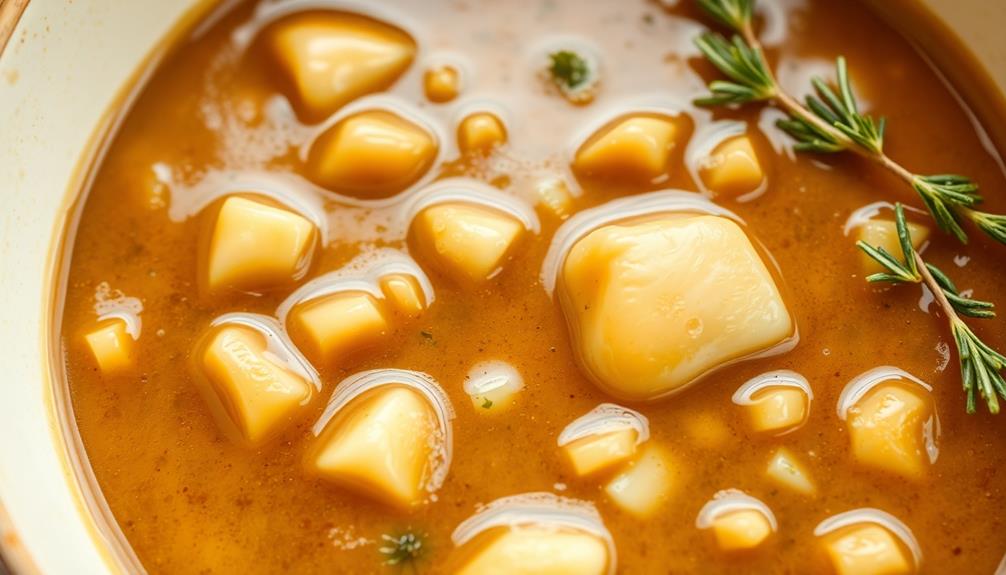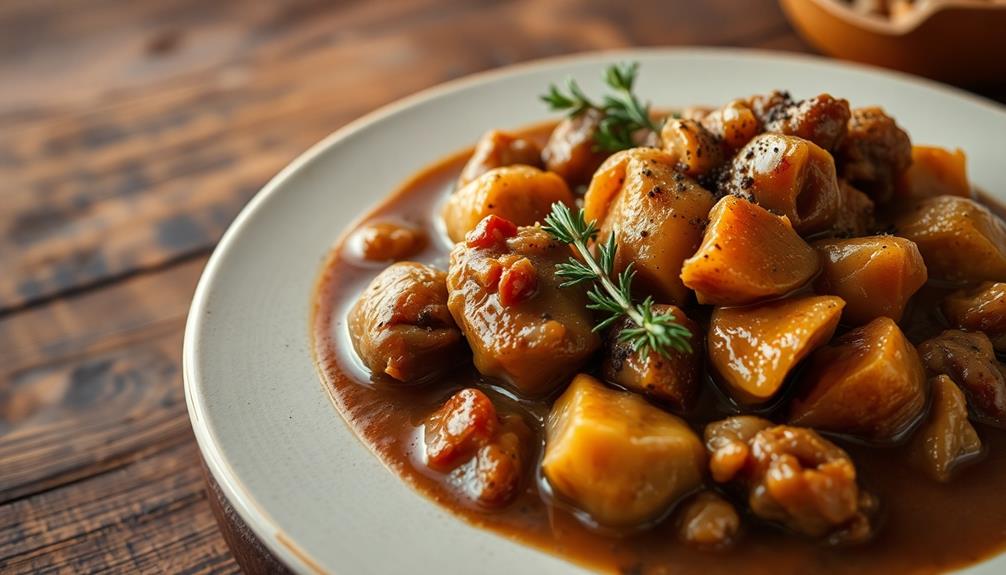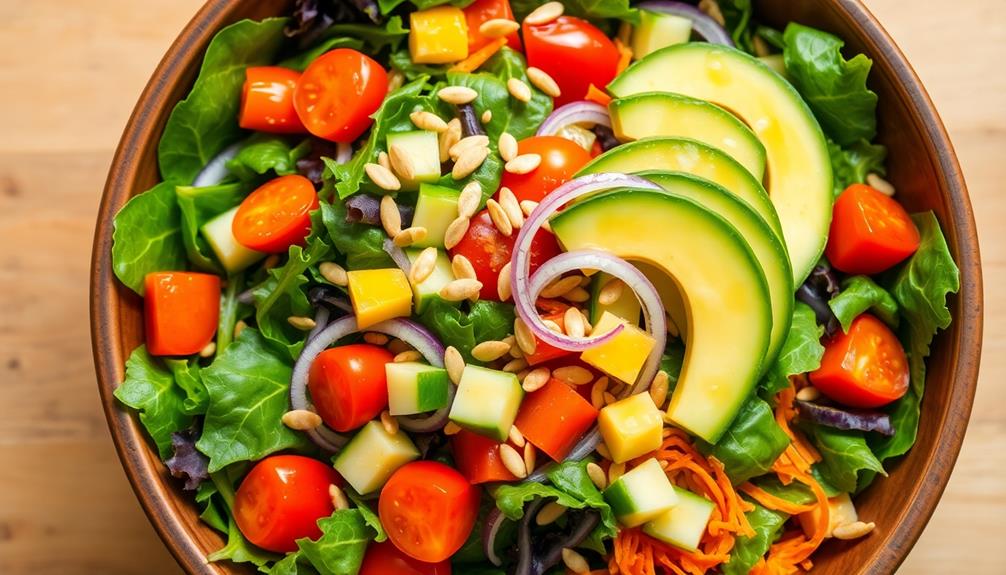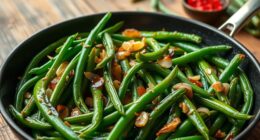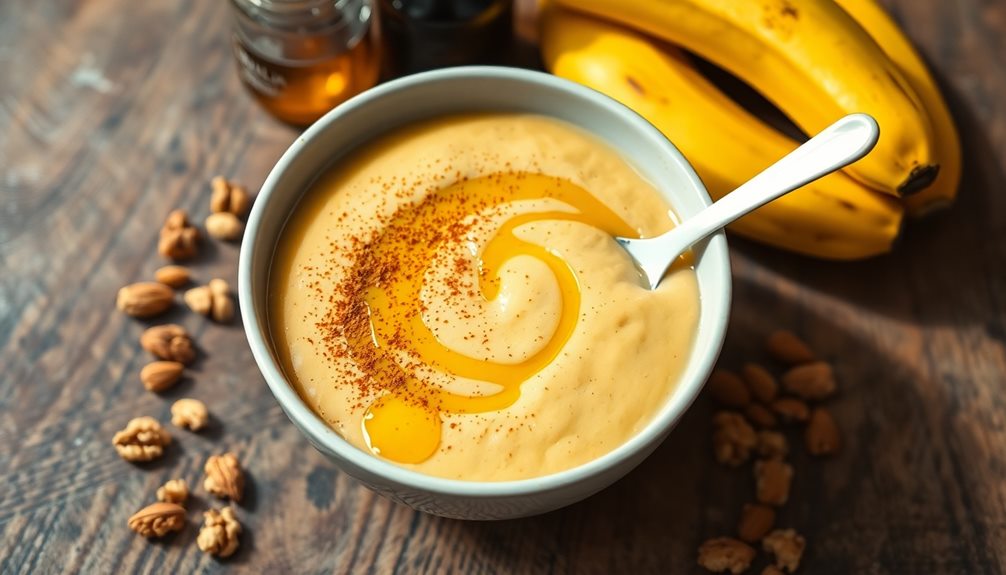Giblet gravy dates back to the Middle Ages, when folks used every part of roast poultry to minimize waste. The term "giblet" refers to edible offal – heart, liver, and gizzard. These were traditionally chopped, simmered, and stirred into a rich, savory gravy. Over centuries, recipes evolved with regional and cultural influences. Today, this classic condiment remains a Thanksgiving and Christmas staple, connecting us to culinary history. To make great giblet gravy, you'll need the giblets, stock, flour, butter, cream, and seasonings. Follow key steps like sautéing the giblets, simmering the broth, and straining for a smooth texture. This versatile gravy complements turkey, chicken, mashed potatoes, and more – let's dive into the details.
Key Takeaways
- Giblet gravy originated in the Middle Ages as a way to utilize every part of roasted poultry, including the heart, liver, and gizzard.
- The main ingredients in giblet gravy are the chopped giblets, chicken or turkey stock, flour for thickening, butter, heavy cream, and seasonings.
- The cooking process involves sautéing the giblets, simmering them in broth, and creating a roux to thicken the gravy before straining.
- Giblet gravy has a rich, savory flavor and a silky texture, making it a versatile condiment that complements various main dishes, including turkey and chicken.
- Leftover giblet gravy can be stored in the refrigerator for up to 4 days and reheated gently to retain its optimal texture and flavor.
History
Where did the tradition of giblet gravy originate? Giblet gravy has been a beloved accompaniment to roast poultry for centuries, dating back to the Middle Ages. The term "giblet" refers to the edible offal, or organ meats, found inside the cavity of a bird, such as the heart, liver, and gizzard.
In early times, these flavorful bits were traditionally saved, chopped, and simmered into a rich, savory gravy to serve alongside the main roast. This practice likely emerged as a way to utilize every part of the bird and minimize waste.
Over the centuries, the preparation of giblet gravy evolved, with various regional and cultural influences shaping the recipes. Today, giblet gravy remains a staple on many Thanksgiving and Christmas dinner tables, a cherished tradition that connects us to the culinary history of our ancestors.
Whether drizzled over the turkey, mashed potatoes, or stuffing, this gravy adds a depth of flavor that elevates the entire meal. This delicious turkey gravy is made with a rich, savory base of turkey drippings, broth, and a touch of seasonings. Its velvety texture and warm aroma make it the perfect complement to any holiday spread. With just the right balance of savory and slightly sweet flavors, this delicious turkey gravy is sure to become a staple at your Thanksgiving table for years to come.
Recipe
Giblet gravy is a classic accompaniment to roasted poultry, particularly turkey. It's a rich, flavorful sauce that adds depth and richness to any holiday meal. Making giblet gravy from scratch may seem daunting, but with a few simple steps, you can create a delicious and satisfying condiment.
The key to a great giblet gravy is to start with high-quality ingredients and to take the time to develop the flavors. The giblets, which are the heart, liver, and gizzard of the turkey, are the foundation of the gravy, providing a savory and earthy base. By simmering the giblets until they're tender, you can extract their maximum flavor potential.
- Turkey giblets (heart, liver, gizzard)
- Chicken or turkey stock
- All-purpose flour
- Unsalted butter
- Heavy cream
- Salt and pepper to taste
Begin by simmering the giblets in a pot of water or stock until they're tender, about 1 hour. Remove the giblets, chop them finely, and set them aside.
In a saucepan, melt the butter over medium heat. Whisk in the flour to create a roux, and cook for 2-3 minutes, stirring constantly, until the mixture is lightly golden. Gradually whisk in the stock, and bring the mixture to a simmer.
Add the chopped giblets and let the gravy simmer for 10-15 minutes, or until thickened to your desired consistency. Stir in the heavy cream and season with salt and pepper to taste.
When preparing the giblet gravy, be sure to taste it as you go and adjust the seasoning as needed. The consistency of the gravy can also be adjusted by adding more stock for a thinner gravy or reducing it further for a thicker, more velvety texture.
Enjoy your homemade giblet gravy with your roasted turkey or other holiday dishes.
Cooking Steps
Chop the giblets into small, even pieces to ensure they cook through evenly.
Sauté the chopped giblets in butter over medium heat until browned.
Next, add the broth and your desired seasonings, then let the mixture simmer until the gravy has thickened to your preferred consistency.
Step 1. Chop Giblets Into Small Pieces
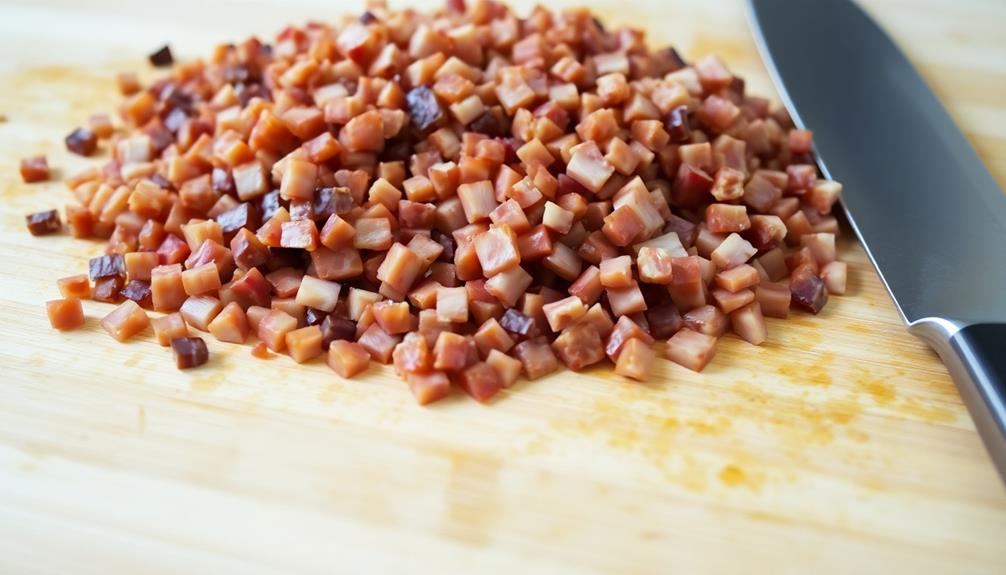
Once you have the giblets prepped, you'll want to chop them into small, even pieces. This step is essential for ensuring the giblets cook evenly and incorporate seamlessly into the gravy. Using a sharp knife, cutting board, and a steady hand, begin by slicing the heart, gizzard, and liver into bite-sized cubes, approximately 1/4 to 1/2 inch in size.
For the neck, it's best to first remove any excess fat or connective tissue, then slice the meat into thin, uniform strips. This will help the neck pieces cook through and blend into the gravy smoothly. Be mindful to work carefully, as giblets can sometimes be tough and fibrous.
Take your time and focus on creating consistently sized pieces to ensure even cooking.
Once all the giblets have been chopped, give them a quick rinse under cool water to remove any final bits of membrane or debris. You're now ready to move on to the next step of the gravy-making process.
Step 2. Saute Giblets in Butter
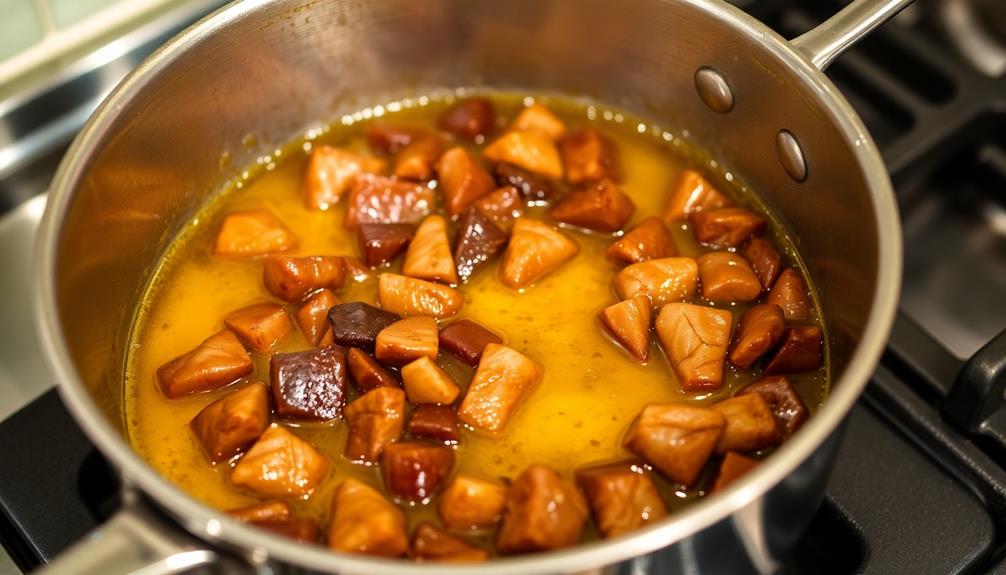
Melt a generous knob of butter in a skillet over medium heat.
Once the butter is hot and foamy, add the chopped giblets.
Sauté the giblets, stirring occasionally, until they're lightly browned and cooked through, about 5-7 minutes.
The key is to not overcrowd the pan – work in batches if needed to ensure the giblets have space to sear and develop a nice caramelized texture.
As the giblets cook, they'll release flavorful juices that will help build the foundation for your gravy.
- Keep an eye on the heat to prevent the butter from burning. Adjust as needed to maintain a steady sizzle.
- For extra flavor, consider adding a pinch of dried thyme, rosemary, or poultry seasoning to the pan.
Once the giblets are ready, transfer them to a plate and set aside.
You'll incorporate them back into the gravy later.
Step 3. Add Broth and Seasonings
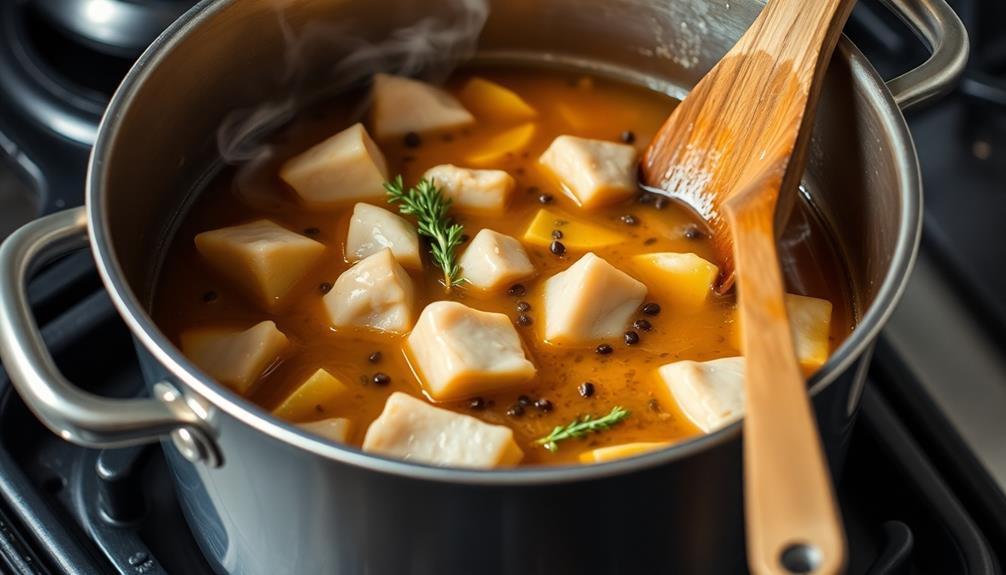
Now that you've sautéed the giblets, it's time to start building the gravy. First, pour in the broth – you'll need about 2 cups of either chicken or turkey broth. Bring this to a gentle simmer, then start adding your seasonings. A pinch of salt and pepper is a must, and you can also incorporate dried herbs like thyme, sage, or rosemary.
For a richer flavor, consider adding a splash of soy sauce or Worcestershire sauce. As the broth simmers, use a whisk to gently incorporate the browned bits from the pan. This will help thicken the gravy and infuse it with the savory essence of the giblets.
If the gravy seems too thin, you can make a simple roux by whisking in a tablespoon of flour. Let it cook for a minute or two to get rid of any raw flour taste. Conversely, if the gravy is too thick, thin it out with a bit more broth.
Step 4. Simmer Until Thickened
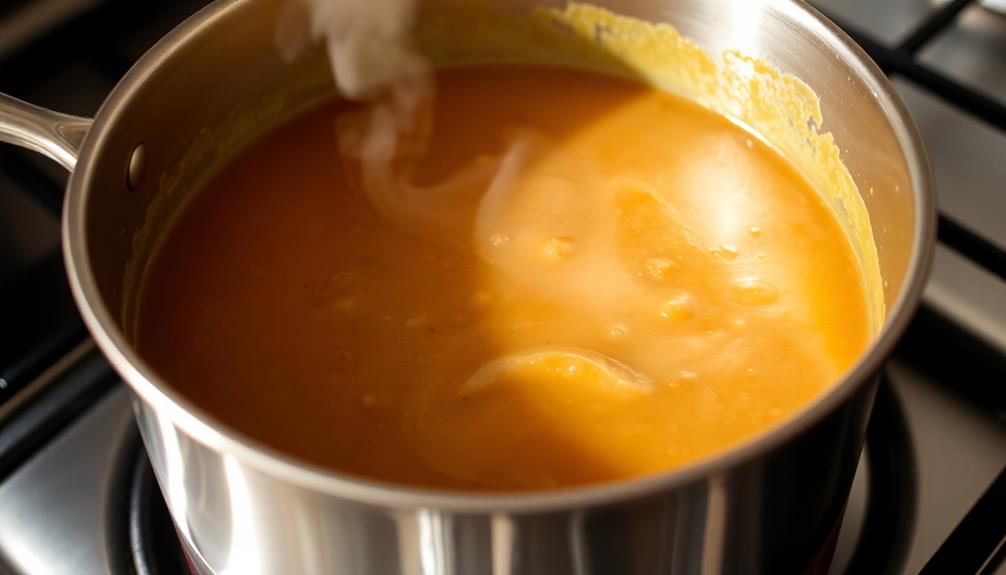
The gravy should now simmer gently, allowing the flavors to meld and the mixture to thicken. This gradual simmering process is crucial for achieving the desired consistency and depth of flavor.
As the liquid slowly reduces, the starches from the roux will gelatinize, creating a rich, velvety texture.
Stir the gravy occasionally to prevent any scorching on the bottom of the pan. The temperature should be set to medium-low, maintaining a gentle bubble rather than a rapid boil. This gentle heat will allow the gravy to thicken without overcooking the ingredients.
Keep a close eye on the gravy, as the time it takes to reach the perfect consistency can vary depending on the amount of liquid and the heat level.
Periodically test the thickness by dipping a spoon into the gravy and running your finger along the back of the spoon. If the gravy readily coats the spoon, it's ready. If it's still too thin, allow it to continue simmering until it reaches the desired consistency.
Step 5. Strain and Serve Gravy
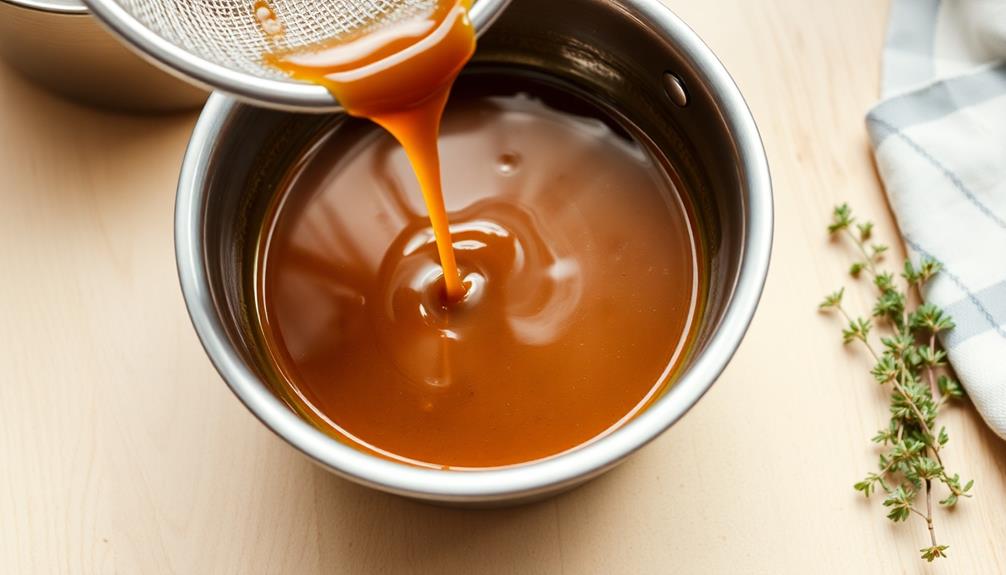
Once the gravy has simmered and reached the desired thickness, carefully strain it through a fine-mesh sieve to remove any small bits or impurities. This step ensures a smooth, velvety texture for your gravy.
Be sure to press down on the solids in the sieve to extract as much of the flavorful liquid as possible.
With the gravy strained, you're now ready to serve. Ladle the rich, savory gravy over your hot turkey, mashed potatoes, or any other dishes you wish to drizzle it over.
The giblet-infused gravy will add a depth of flavor that elevates the entire meal.
If you have any leftover gravy, allow it to cool completely before transferring it to an airtight container in the refrigerator.
It will keep for up to 4 days, so you can enjoy it again later. Reheat gently on the stovetop or in the microwave before serving.
Final Thoughts
Achieving the perfect giblet gravy requires patience and attention to detail. With the right techniques, you can create a rich, flavorful sauce that elevates any holiday meal.
Remember, the key to success lies in the preparation – from simmering the giblets to carefully straining the gravy.
While the process may seem daunting, take pride in your handiwork. The time and effort you invest will be evident in the final result.
Serve your giblet gravy with confidence, knowing that you've mastered a time-honored tradition. Your guests will be impressed by the depth of flavor and the silky texture.
Don't be afraid to experiment with additional seasonings or herbs to suit your personal taste. The beauty of this recipe is its versatility – it can be tailored to complement a wide range of main dishes.
Frequently Asked Questions
Can I Substitute Turkey Giblets With Chicken Giblets?
Sure, you can substitute turkey giblets with chicken giblets in your recipe. The key is to adjust the cooking time and seasonings to account for the different flavors of the chicken giblets. Give it a try – it'll work just fine!
How Long Do Leftover Giblet Gravy Last in the Fridge?
Leftover giblet gravy can last in the fridge for 3-4 days. Be sure to store it in an airtight container, and reheat it thoroughly before serving. Enjoy your flavorful gravy while it's still fresh!
Is It Possible to Make Giblet Gravy Without the Giblets?
Yes, you can make giblet gravy without the giblets. Use a rich chicken or turkey stock as the base, and add aromatics, herbs, and a roux to thicken it. The result will be a flavorful gravy, just without the actual giblets.
What's the Best Way to Reheat Leftover Giblet Gravy?
The best way to reheat leftover gravy is to do so gently over low heat, stirring frequently to prevent scorching. You can also reheat it in the microwave, but be sure to stir it periodically to ensure even warming.
Can I Freeze Giblet Gravy for Later Use?
Yes, you can freeze giblet gravy for later use. Just be sure to let it cool completely before transferring it to an airtight container or freezer bag. When ready to use, thaw in the refrigerator and reheat gently on the stovetop.
